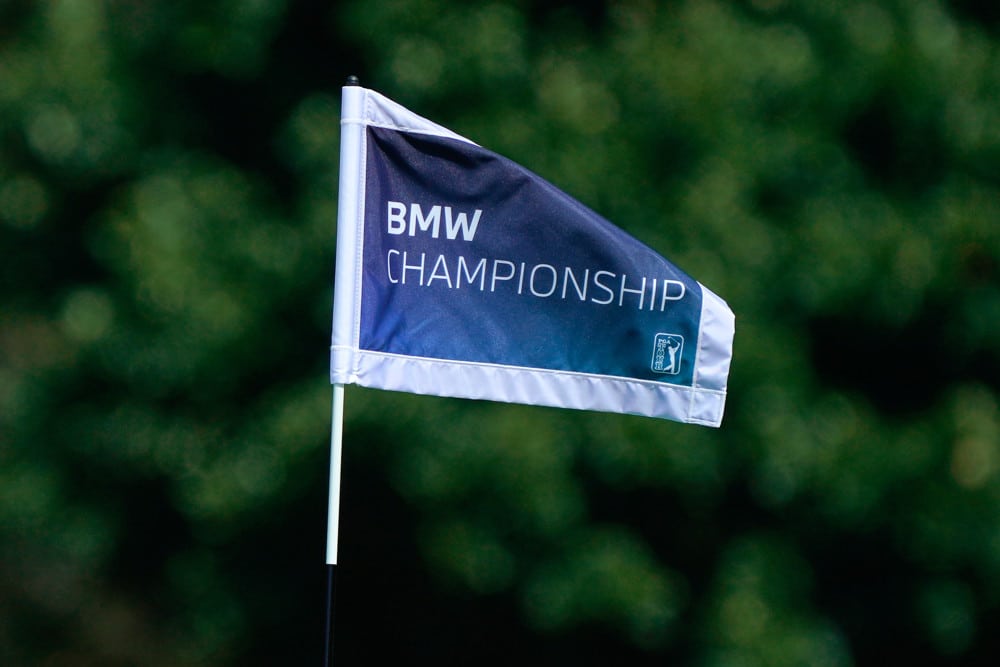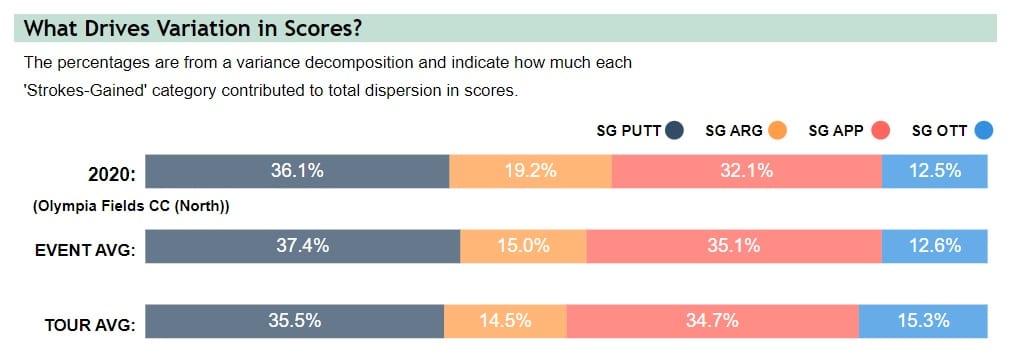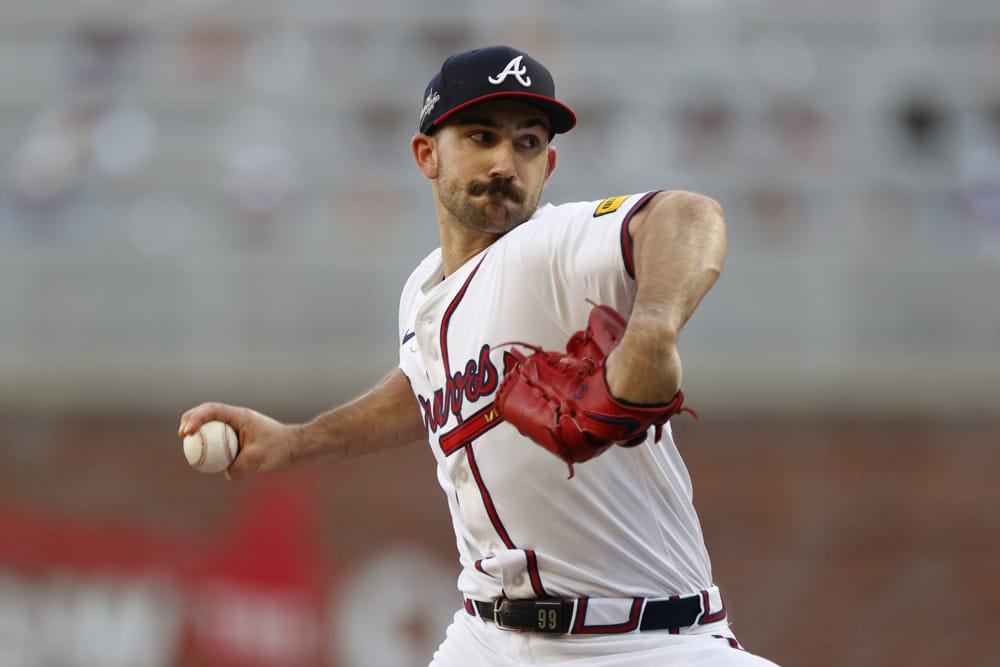The second leg of the FedEx Cup playoffs is upon us. The Top 50 players in the standings head to Chicago, IL, for the 2023 BMW Championship at Olympia Fields Country Club. As always, here is a preview of the 2023 BMW Championship and a guide to betting the tournament.
2023 BMW Championship Preview
The Golf Course
One of Chicago’s oldest clubs, Olympia Fields Country Club, was founded in 1915. There were four golf courses on-site designed by two-time Open Championship winner Willie Park, Jr. While Park, Jr. is responsible for over 170 golf courses across the British Isles, Canada, and the United States. His other notable golf courses include Kilspindie and Gullane in Scotland and the New Haven Country Club in Connecticut.
The club faced financial difficulties in World War II and was forced to sell half its land for residential development. It then turned Course No. 4 into the North Course, which will host this week’s BMW Championship.
There have been very few changes to the golf course since the North Course was constructed (other than a lengthening to just under 7,400 yards). Right off the bat, you can see a lot of classical Scottish design traits in the layout. Both the front nine and the back nine have in-to-out characteristics, both stretching to the farthest points of the property before winding back to the clubhouse.
In addition, fairways are pinched in around the landing zones by bunkers to challenge players off the tee. However, those who take on the bunkers can be rewarded with a better angle into certain pin positions. Overall, the fairways generally are about 30 yards wide and flanked by ankle deep rough and rows of trees. And while there is a creek that meanders its way around the property, the only hole where it’s truly in play is down the right side of the 17th fairway.
There aren’t many modern reference points to refer to when handicapping this event. Most recently, it hosted the 2020 BMW Championship, which was won by Jon Rahm. However, the weather conditions were much different for the 2020 BMW Championship than it will be this week (much more on that below). It also hosted the 2015 U.S. Amateur, which was won by Bryson DeChambeau.
After 2003, the greens were in very rough shape, and in 2006 the golf course underwent some reconditioning. The bentgrass putting surfaces for the North Course was revitalized, as well as an improvement of existing bunkers and the addition of new fairway bunkers.
Overall, Olympia Fields Country Club is a stern test of golf draped across a beautiful parkland setting.
Betting Strategies
To kick off the betting strategies, we need to discuss how the golf course will play differently than it will in 2020, specifically with course conditions.
Here are the highlights of the final round of the 2020 BMW Championship:
Back in the summer of 2020, there were drought conditions in much of the Northeast and Midwest United States. As such, Olympia Fields played really, really firm for the 2020 BMW Championship. So firm that balls often bounded off the fairway and into the rough. And any approach shots from the rough stood almost no chance of hitting it close to the pin. It was an extremely fast golf course. And the driving accuracy and green in regulation rates that week was comically low.
However, the weather conditions for the 2023 BMW Championship will likely deliver a different golf course. We have polar opposite conditions heading into this year’s tournament at Olympia Fields. There has been a ton of rain in the Midwest this summer. As such, Olympia Fields should play much softer, slower, and more receptive than it did in 2020.
All this needs to be accounted for when looking back at the 2020 BMW Championship for insights on how the golf course will play. Some aspects of that tournament will remain. Others, not so much. As such, each section will attempt to take the changing weather conditions into account to see if what we saw in 2020 will hold or if gamblers need to shift gears.
Let’s start with some general information & agronomy of the North Course at Olympia Fields
General Information & Agronomy
The North Course at Olympia Fields plays to a Par 70 at 7,366 yards. There are two Par 5’s, four Par 3’s, and twelve Par 4’s.
Par 3’s
These were the average yardages of every Par 3 at Olympia Fields at the 2020 BMW Championship, as well as their overall difficulty that year.
- Hole No. 6: Avg: 174.3, 8th easiest
- Played as long as 190 yards in the second round and as short as 149 yards in the third round.
- Hole No. 8: Avg: 233.5, 2nd toughest
- 45% of the players in the 1st round made bogey or worse on the hole.
- Hole No. 13: Avg: 158.5, 7th easiest hole
- Played under par in three of the four rounds.
- Hole No. 16: Avg. 206.5, 5th toughest hole
- Only 22 birdies all week on the hole (8% birdie rate)
In 2020, the Par 3’s at Olympia Fields played to an average yardage of 194 yards. They were also the 11th longest Par 3’s played on the PGA Tour that season. In addition, difficult conditions at the tournament saw the Par 3’s play as the 6th toughest in the entire 2020 season.
While technically, there is a water hazard on the 8th and 16th. They’re only in play for us mortals who duff shots off the tee. For the professionals, they’re nowhere near where their ball will land. Overall, their sheer difficulty in 2020 was because of the firmness of the greens and the wind.
Holes 8 and 16 will still play tough because of their length. But they won’t be near the brutes they were in 2020 because of how soft the greens are anticipated to be. Meanwhile, players are probably going to light up Holes 6 and 13 as long as the tournament directors don’t put down circus pins.
Unless we see as much wind as the players faced in 2020, don’t expect the Par 3’s to play nearly as difficult as they did in 2020. But if the wind kicks up, the sun comes out, and the golf course firms up a bit, watch out.
Par 4’s
These are the yardage ranges of every Par 4 at Olympia Fields, per the 2020 BMW Championship:
- < 375 Yards: 0.0%
- 375-400 Yards: 16.7%
- 400-425 Yards: 16.7%
- 425-450 Yards: 15.7%
- 450-475 Yards: 37.5%
- 475+ Yards: 12.5%
Half of the Par 4’s at Olympia Fields plays over 450 yards. On average, holes 2, 3, 7, 9, 17, and 18 all played over 450 yards at the 2020 BMW Championship. In firmer conditions and a helping wind, the Par 4 11th was drivable for the field. However, given the softer fairways, it likely won’t be reachable with a tee shot in 2020.
The defense of the Par 4’s is primarily narrow fairways, pinched-in fairways protected by bunkers, and thick Kentucky Bluegrass rough. And with the firm conditions seen in 2020, they were incredibly difficult to hit the fairway on these holes. However, almost all the holes are very linear in design. Players don’t have to plod around and play positional golf as much as they had to last week at TPC Southwind on these Par 4’s.
While there is water on the golf course, it’s not in play all that often. Butterfield Creek bisects the property. But the only time it’s in play off the tee is down the right on Hole No. 14. Otherwise, it acts more as a defense to force layups off the tee. It’s far enough out that players can’t carry it, but pulling the driver creates the risk of the ball running out into it, especially in firm conditions.
There’s also a pond short of the 18th green, but it’s not in play unless someone hits a truly horrible shot out of the rough.
In 2020, the Par 4’s at Olympia Fields played as the third toughest on the PGA Tour that season. Again, the culprit is likely the firm and windy nature of the golf course that week. With softer conditions making it easier for balls to stay in the fairway, along with more receptive greens, the Par 4’s won’t be as tough as they were in 2020 (unless, again, we see wind and sun during the tournament).
However, there are definitely some brutish holes at Olympia Fields. For example, No. 18 is an incredibly difficult closing hole, playing on average at 499.5 yards in 2020. There’s nowhere to hide on the hole. Players must pull driver and hit a long and accurate shot with a driver. Anything that finds the thick rough or the bunkers likely won’t allow to hit the green in regulation.
Overall, the Par 4’s are an execution test at Olympia Fields. Everything is right out in front of the player. In many ways, they resemble the Par 4’s seen at places like Winged Foot and Oak Hill. The gambit at all three places is whether one can hit a long and accurate shot off the tee with a driver. If so, players can go for pins. If not, they’re likely scrambling to save par.
Par 5’s
There are only two Par 5’s at Olympia Fields. There are their yardages and their overall difficulty at the 2020 BMW Championship.
- Hole No. 1: Avg. 617.8, Easiest Hole
- Only about a third of the field made birdie or better on the hole during the 2020 BMW Championship.
- There were only three eagles on the hole during the week.
- Hole No. 15: Avg. 600.8, 3rd Easiest Hole
- Only about a quarter of the field made birdie or better on the hole during the 2020 BMW Championship.
- Played over par in the 2nd round.
Both the Par 5’s are very, very long. Each averaged over 600 yards in length during the 2020 BMW Championship. However, the holes played much shorter than the advertised yardages because of how firm the fairways were. Balls that found the fairway ran forever, creating huge driving distances on the hole.
However, both holes played very tough relative to other PGA Tour Par 5’s that season. The Par 5’s at Olympia Fields were the 2nd toughest during the 2020 season. Only 29% of the field made birdie or better on the hole. Between the unreceptive greens and the forced layups anytime someone missed a fairway, these were a pair of stout Par 5’s.
Counterforces might mean that the Par 5’s play difficult again. The anticipated softer conditions will be much more receptive to longer approach shots into the green, thereby increasing the green in regulation rate and increasing birdie or better opportunities with a putter.
However, the softer fairways also mean the holes will play much longer than they did in 2020. It’s possible that the holes won’t play nearly as long as they did in 2020, as forward tee boxes might be used. If not, and the holes play again over 600 yards, long hitters who have the ability to get to the green in two might have a huge edge on the holes in 2023.
Agronomy
The entire golf course is essentially a wall-to-wall mixture of bentgrass and poa annua. The greens, collars, approaches, and fairways are all a bent/poa mix. The rough is 4+ inches of Kentucky Bluegrass rough.
It’s unknown what the exact ratio of bentgrass to poa mix it is at Olympia Fields. At some places, it’s much more bent than poa. At other places (such as Detroit Golf Club), it’s more poa than bent. Nevertheless, here are recent golf courses on the PGA Tour that feature a bent/poa mixed green complex:
- TPC River Highlands (Travelers Championship)
- Detroit Golf Club (Rocket Mortgage Classic)
- Silverado Resort and Spa (Fortinet Championship)
- Tahoe Mountain Club (Barracuda Championship)
- Oakdale Golf & CC (2023 RBC Canadian Open)
- Muirfield Village pre-2021 renovation (the Memorial)
- Hamilton Golf & CC (2019 RBC Canadian Open)
- Bethpage Black (2019 PGA Championship)
- Tahoe Mountain Club (Barracuda Championship)
Combined with its narrow fairways, Olympia Fields is certainly looking to punish golfers who miss fairways with thick and long bluegrass rough. However, these conditions sometimes can favor longer hitters who either hit it so far offline their tee shot lands in trampled rough or they have the clubhead speed to gouge a short iron close or onto the green, whereas a shorter hitter is essentially punching out.
Golfer Skillsets
Here is how Olympia Fields challenges players in each of the four skillets of golf:
Off The Tee
In 2020, Olympia Fields played as the 7th toughest golf course off-the-tee that season. Since 2015, it was the 16th toughest of all golf courses played on the PGA Tour.
There certainly are some challenges posed by Olympia Fields based on its architecture. For starters, the golf course is quite narrow. Per DataGolf, the effective width of the fairways at Olympia Fields in 2020 was only 26.4 feet. That’s the narrowest fairways played on the PGA Tour in the 2020 season and 3rd most narrow of all golf courses played since 2015.
In addition, the rough was grown quite thick for the 2020 BMW Championship. It was cut at 4 inches in most spots, with longer rough grown well off the fairway. And because COVID prevented fans from enjoying the tournament on-site, none of it was trampled down. As such, players who sometimes catch lucky breaks with decent lies after wild misses didn’t enjoy such good fortunes at the 2020 BMW Championship.
Finally, thick swaths of trees flank every fairway at Olympia Fields. Players were at the mercy of the bounces of the trees to where their ball would ultimately end up. And as mentioned previously, balls that dropped straight down that normally would wind up sitting on trampled-down rough from the gallery now found itself in some of the thickest rough on the golf course. The only option at that point was a punch out.
Despite these challenges, players have to pull driver a lot at Olympia Fields. Olympia Fields is a very linear golf course tee-to-green. Players can see the green from the tee box on almost all the holes. And only a couple of holes feature either a cross bunker or creek that might force a layup. But otherwise, players must hit drivers a lot at the golf course. There’s no hiding from it.
What Olympia Fields doesn’t have, however, is the threat of incurring penalty strokes off the tee. There’s only one Par 4 that brings a water hazard into play. And while some players incurred penalties because there was no gallery to help spot a ball when a tee shot was wildly missed, that likely won’t be the case this year.
But the biggest reason Olympia Fields played so challenging off the tee in 2020 was the turf conditions. The fairways were so firm and fast that it simply was incredibly difficult to keep the ball in the fairway. Unless a tee shot was dead straight, even good drives slightly off of center would bound into the intermediate and primary cut of rough.
That helps explain why the field driving accuracy rate that week was only 46%. That was the lowest accuracy rate on the PGA Tour that season. And it was the third fewest fairways found of all golf courses played on the PGA Tour since 2015.
Overall, Olympia Fields was the 10th costliest of course in 2020 to miss a fairway at. But it was all due to the rough. There was roughly a 0.4 stroke penalty on a hole between tee shots that found the fairway and those that found the rough. That was the 3rd highest penalty in the 2020 season and 11th overall since 2015. However, only 2.1% of all tee shots incurred a penalty stroke off the tee. That ranked 19th out of 29 golf courses played on the PGA Tour in 2020. And 56th overall of all golf courses played since 2015.
Olympia Fields was a great preview of what was to come at Winged Foot a month later. Both golf courses featured narrow corridors with rock hard fairways that made keeping the ball in the short grass incredibly difficult. And both golf courses played almost identically to each other off the tee.
In-Tournament distance was significantly more influential on gaining (or losing) strokes off-the-tee at each venue than the normal PGA Tour stop. Much more than in-tournament accuracy, which typically is the bigger driver of gaining (or losing) strokes off-the-tee at most PGA Tour venues.
So will it play just as tough for the 2023 BMW Championship? Probably. There’s no expectation for the rough to not be as thick, nor for the fairways to be cut more wide. The same challenges players faced in 2020 will be present in 2023.
However, there will be a few changes based on the anticipated softness of the fairways. For starters, it should be much easier to keep the ball in the fairway should its first landing spot be in the short grass. The fairways won’t be nearly as firm as they were in 2020, and good tee shots should stay in the fairway. However, I still don’t expect the driving accuracy rates this week to be more than 55%.
In addition, wild misses off the tee might have a little better fortunes in 2023 than those in 2020. There will be lots of people on the grounds this year at Olympia Fields. And their presence outside the ropes will trample down the rough. That should reduce the penalty for wild misses a lot. While players will still have to punch out, their chances of advancing the ball near the green are a lot better than they were in 2020.
Lastly, the golf course should play a lot longer than it did in 2020 with the softer conditions. The fairways should run a lot slower than they did in 2020. And even though there should be higher driving accuracy rates, they won’t be high enough to make up the difference.
Overall, however, I don’t see a material difference in what gamblers should focus on off-the-tee at Olympia Fields. Distance should remain as a big edge in 2023 as it was in 2020. There might be a little higher reward for in-tournament driving accuracy than there was in 2020, but not by much.
Approach Play
In 2020, Olympia Fields was the 7th toughest with approach shots. Since 2015, it ranks as the 13th toughest of all golf courses played on the PGA Tour. For shots under 150 yards, it ranks as the 3rd toughest on all golf courses played since 2015. And on shots over 150 yards, it ranked as the 8th toughest in 2020 and 22nd overall since 2015.
Like it was for off-the-tee, the difficult turf conditions is what made the approach shots quite challenging. In 2020, the greens that week were like concrete. The sound balls made when it hit the putting surface sounded much more like a thud than a splat you would hear on a softer golf course. And approach shots, especially mid to longer ones, that came from the rough stood little chance of getting the ball near a pin or even keeping it on the green.
As such, the green in regulation rate in 2020 was very low. Only 55.2% of the field managed to hit the green in regulation. That was the 3rd lowest rate during the 2020 season and 5th lowest overall of all golf courses played since 2015.
Conditions shouldn’t be quite as difficult as they were in 2020, though. For starters, the greens should be a lot more receptive, given the anticipated softer nature of them. And assuming more tee shots will manage to stay in the softer fairways in 2023, I expect the green in regulation rate to creep up to the low 60% range. It should allow players who find the fairway to play more aggressively toward pins. And it should make it easier for players who hit approach shots from the rough to hold greens.
Nevertheless, the approach shots should remain difficult overall, even with softer conditions. The greens at Olympia Fields have a fair amount of undulation to them and should still run quite fast on the stimpmeter. Accessing certain pin positions will still be a chore as the targets will be quite small. Two approach shots within feet of each other could end up in wildly different places on the green.
Below is where players hit approach shots from in 2020. This will preview the types of approach shots players will hit at the 2023 BMW Championship:
In 2020, about 42% of the approach shots came from between 125 and 175 yards. That’s higher than the PGA Tour average. There also was a much higher percentage of shots over 250 yards than the PGA Tour average in 2020.
Assuming the fairways play a little softer and lengthen the golf course a bit, shift these proximity buckets a tier or two. Overall, I would expect a higher composition of shots between 150-200 yards than there was in 2020. As such, shift the focus more towards mid iron and long iron play this week.
Around The Green
In 2020, Olympia Fields played as the 7th toughest golf course around the green on the PGA Tour that season. And since 2015, it played as the 20th most difficult around the green.
Again, the turf conditions played a big part to the difficulty of Olympia Fields around the green. Most of the greens are flanked by very thick and long rough. How well a player does out of this rough is lie dependent (i.e., based on luck). And often times it’s a complete guess how well (or poorly) balls will come off the clubface and onto the green.
The fact that players are guessing how well or poorly balls will come out of the rough makes it more difficult when they’re chipping back onto firm, fast, and significantly undulated greens. And that’s the challenge the players faced at Olympia Fields in 2020. There was a very fine line between a great chip and a poor one because of the uncertainty of how hot or slow the ball would come off the club face.
There also, however, are a lot of tight lie areas around the green. And players struggled a lot chipping off of these. There are a few examples in the video below of the worst shots hit at the 2020 BMW Championship of players having a very difficult time off the tight lies around the green:
In 2020, Olympia Fields played as the 10th toughest from tight lies, 4th toughest from the rough, but only 14th out of 29 courses from a bunker. So the most difficult areas to miss at were definitely in the rough and from the collection areas.
I would expect similar difficulties in 2023. While the greens will be a little softer, it should still be similar conditions that players faced in 2023. There will still be a lot of luck involved with balls that find the thick rough and the uncertainty of how it’ll come out of it. And there will still be difficulties chipping off of tight lies. Expect similar difficulties around the green in 2023 at the BMW Championship.
Putting
In 2020, Olympia Fields played as the 8th toughest in putting on the season and 18th overall on all golf courses played since 2020. While putting under 5 feet wasn’t a huge challenge, there was extreme difficulty on putts over 15 feet. It ranked as the toughest on putts greater than 15 feet in the 2020 season and 7th overall in 2020.
The greens at Olympia Fields are both significantly undulated and very fast. They’ll run 12.5 on the stimpmeter, and if the greens firm up over the weekend, they’ll run 13+. As such, putting from long ranges at Olympia Fields is a very difficult task.
How much the ball can move on long putts is evident on Jon Rahm’s winning putt at the 2020 BMW Championship, as well as Dustin Johnson’s long-range putt to force a playoff:
Even though the greens should be a little softer, they should run just as fast as they did in 2020. As such, expect similar difficulties in 2023 as the players faced in 2020.
Predictive Skillsets
Here is the predictive skillset chart that shows the types of players that typically do well at Olympia Fields:
While the golf course played very difficult, from a predictive standpoint, Olympia Fields played about as run of the mill as one would think a typical PGA Tour event would go. The players one would think would do well on the PGA Tour did well at Olympia Fields. Length off the tee was a better predictor of success than driving accuracy. Iron play was as predictive of success as it would be at a normal PGA Tour stop, as was putting and around the green play.
This year, I would expect that performance off-the-tee (particularly with distance) and iron play will be a little more predictable toward success at Olympia Fields than it was in 2020. Due to more receptive fairways and greens, players who typically gain a ton of strokes with the ball striking should be a little more likely to do well at Olympia Fields than the predictive measurements suggested for the 2020 tournament.
In Tournament Strokes Gained
Lastly, here is a distribution chart of the variance in total strokes gained based on in tournament performance. This chart demonstrates what forces have an influence on how a player separates themselves from the field:
One would think that given the composition of the final leaderboard, as well as the overall difficulty of the golf course, that the ball striking categories would have a much higher influence on the variance in total strokes gained at the 2020 BMW Championship than the PGA Tour average. But it wasn’t. So how can a final leaderboard where Dustin Johnson, Jon Rahm, Hideki Matsuyama, Joaquin Niemann, and Tony Finau contend be determined mostly from an up and down and putting match?
It’s because of how difficult it was to find fairways and greens that week. Hitting fairways was essentially a crapshoot all week. And because the green in regulation rate was only about 55% for the week, players were spending a lot more time trying to get up and down than they were at the normal PGA Tour stop. That’s why around the green and putting performances were way more impactful toward separating oneself from the field than the ball striking statistics were.
Almost the same thing happened at Winged Foot a month later:
Given the expected softer fairways and more receptive greens at the 2023 BMW Championship, the ball striking statistics should have a bigger contribution to the variance in scoring than it did in 2020. Both the driving accuracy rates and the green in regulation rates should go up in 2023. As such, the importance of in-tournament ball striking will increase at the expense of scrambling and putting.
However, the green in regulation rates still should be lower than the PGA Tour average, and the greens will probably be just as slick and difficult. They’ll still play a big factor in the variance in scoring at the 2023 BMW Championship. Just not as impactful as it was in 2020.
Executive Summary
So what are the main takeaways from this preview of the 2023 BMW Championship? Here are the main points to focus on for the 2023 BMW Championship:
1. Olympia Fields is a Par 70 with bent/poa fairways and greens, with 4+ inch Kentucky Bluegrass.
2. The golf course probably won’t play nearly as fast and firm as it was in 2020. As such, the golf course should be a little more receptive in 2023. Expect both driving accuracy rates to increase, as well as green in regulation rates. That will make the golf course play easier than it did in 2023.
3. While the ability to find fairways will increase, the combination of narrow fairways, thick rough, and trampled down rough for wide misses should mean that driving distance remains a very important edge at Olympia Fields.
4. While the greens should be a little more receptive than they were in 2020, the golf course will probably play a little longer due to the slower fairways. As such, put more of a focus on shots between 150-200 yards this year.
5. The greens should still be fast and undulating as they were in 2020. As such, putting from long range should still be a difficult task.




























